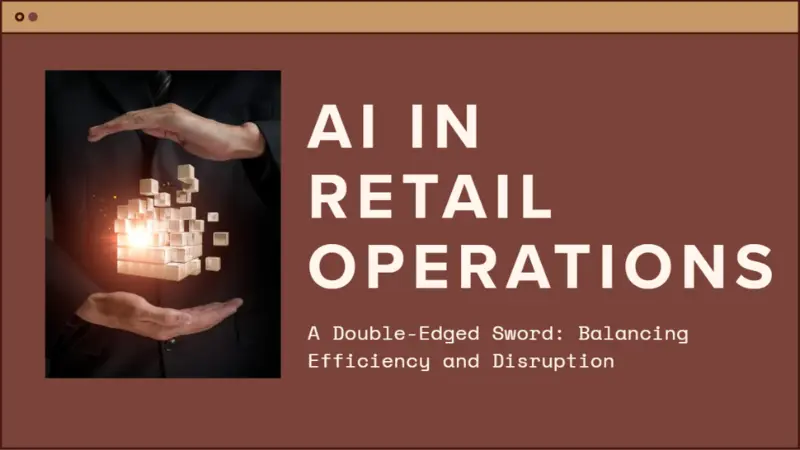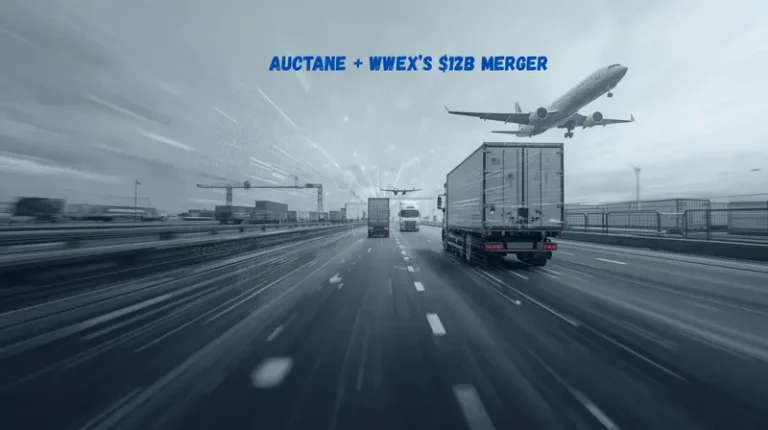AI in Retail Operations: Reshaping the Future of Retail

Last updated on August 21, 2025

In this article
 17 minutes
17 minutes
- Introduction: The Retail AI Paradox
- AI is Everywhere in Retail Operations (and That’s a Good Thing)
- The Coming Disruption: AI-Powered Shopping Agents and Changing Consumer Behavior
- Bridging the Gap: What Retailers Should Do Now
- Summary: Embrace the Paradox for Retail Success
- Frequently Asked Questions
Introduction: The Retail AI Paradox
In the retail world, we’re facing a bit of an AI paradox. On one hand, AI in retail operations is a powerhouse for efficiency; it can optimize everything from inventory management to dynamic pricing, making businesses run leaner and smarter. On the other hand, the rise of AI-driven shopping (think intelligent agents making purchases for consumers) threatens to disrupt traditional retail models in ways we’re only beginning to grasp. I’ve been watching this space closely, and the signal is clear: retailers must embrace AI to streamline and survive today, even as they brace for the bigger shifts AI could cause in customer behavior tomorrow.
As one industry observer from AWS (Amazon Web Services) hinted, retailers should “optimize for efficiency, prepare for disruption.” That phrase sums it up nicely. You want to use AI tools to sharpen your operations and improve customer satisfaction, but you also need to keep an eye on how AI technologies are changing shopper expectations and competitive dynamics (the disruption part). Let’s unpack this paradox and explore both sides, the here-and-now benefits of AI and the looming changes on the horizon.
Slash Your Fulfillment Costs by Up to 30%
Cut shipping expenses by 30% and boost profit with Cahoot's AI-optimized fulfillment services and modern tech —no overheads and no humans required!
I'm Interested in Saving Time and MoneyAI is Everywhere in Retail Operations (and That’s a Good Thing)
First, the obvious part: artificial intelligence is increasingly embedded in nearly every facet of retail operations. We’re well past the days of AI being a novelty or confined to a pilot project. Today, if you’re not leveraging AI in some form, you’re already behind. Here are some key areas where AI is improving efficiency and decision-making in retail:
- Demand Forecasting: Gone are the times of forecasting based only on last year’s sales and a spreadsheet. Modern AI systems ingest historical sales data, real-time trends, market trends, even weather and social media cues to predict demand with remarkable accuracy. This means retailers can anticipate how much of each product to have and where, reducing stockouts and overstocks. A 2025 study by OpenText noted that AI-driven forecasts are “far more accurate than traditional methods”, integrating diverse data points to predict demand with unprecedented precision. Fewer stockouts means happier customers and fewer lost sales; less overstock means lower holding costs and markdowns. It’s directly boosting the bottom line.
- Automated Inventory Management: Inventory management itself has been supercharged by AI. Machine learning models can determine optimal reorder points for each SKU, triggering restocks automatically. They factor in lead times, current velocity, and even competitor pricing changes. Some large retailers have AI that reallocates inventory across stores. If one location’s stock of an item is moving slowly but another can’t keep it on shelves, an AI might prompt a transfer to balance it out. Computer vision is also used in warehouses to monitor inventory levels (smart cameras that “see” when shelf stock is low) and even in stores (Amazon’s Just Walk Out tech, for example, automatically tracks when items are taken so inventory is updated in real-time). All this reduces labor and errors. It’s not sexy to customers, but operationally it’s a big efficiency gain.
- Dynamic Pricing and Markdown Optimization: AI allows truly dynamic pricing strategies that would be impossible to do manually. By analyzing sales patterns, inventory aging, and competitor prices, AI can adjust prices in real time to maximize revenue. For instance, if data shows a certain apparel item isn’t selling as fast as predicted, an AI system might initiate a slight price drop or a promotion to boost demand, rather than waiting for an end-of-season clearance. Alternatively, for high-demand products, AI might inch prices up (within allowed limits) to capitalize on willingness to pay. These pricing strategies are increasingly common in ecommerce but are also hitting brick-and-mortar via electronic shelf labels and apps. The result is higher operational efficiency, you sell products closer to the ideal price point, improving margins without manual intervention on each pricing decision.
- Supply Chain Optimization: Retail supply chains are getting smarter through AI analytics. Everything from predicting delays (using AI to analyze weather, political climate, etc.) to optimizing supply chain management (choosing the best shipping routes and methods) can be AI-driven. For example, AI can analyze past shipping data and real-time freight rates to suggest the most cost-effective way to move goods (should I ship by rail or truck for this distribution lane this week?). Supply chain analytics provided by AI also help retailers respond faster, if there’s a hint of disruption (like a factory issue or port delay), AI systems flag it early by detecting anomalies, giving retailers a head start to reroute or adjust orders. This improves resilience and reduces costly last-minute expediting.
- Workforce and Task Optimization: Beyond merchandise, retailers use AI to improve store operations and workforce management. AI can forecast foot traffic by time of day, helping set optimal employee schedules (so you’re not overstaffed during lulls or understaffed during rushes). It can also prioritize tasks, for instance, if an AI sees that online orders for curbside pickup are spiking on Monday mornings, it might prompt managers to assign more staff to picking and packing at those times. Some stores even use AI-driven robots to scan aisles for out-of-stock items or misplaced products, freeing up human staff for customer service tasks.
All these examples point to one thing: operational efficiency. Retail is a low-margin game, and AI is helping shave off costs and improve throughput in countless small ways that add up. According to the National Retail Federation (NRF), leading retailers leveraging AI have significantly improved metrics like inventory turnover and markdown rates, translating into percentage points of margin improvement. In fact, top retailers (the Walmarts and Targets of the world) are achieving notable cost reductions; one stat I came across said the top 5% of retailers have 31% lower fulfillment costs through integrated automation and AI, compared to the average. That’s huge in an industry where a 1% margin improvement is celebrated.
From a customer perspective, they might not see these AI tools, but they feel the effects: products are in stock more often, they get what they want when they want it, and even pricing can feel more “right” (no massive end-of-season gluts or mysterious price jumps). Customer satisfaction benefits from these back-end optimizations.
Case in point: Look at how a company like Stitch Fix (an online apparel retailer) used AI. They combined AI algorithms with human stylists to improve customer insights and inventory alignment. The AI would analyze customer profile data (size, style preferences) and purchase patterns to suggest what inventory to buy and how to personalize outfits for each customer. The result was less excess inventory and a more personalized, satisfying experience for the shopper, i.e., operational efficiency meeting customer experience improvement. This dual win is why AI’s ROI in retail has been compelling.
Looking for a New 3PL? Start with this Free RFP Template
Cut weeks off your selection process. Avoid pitfalls. Get the only 3PL RFP checklist built for ecommerce brands, absolutely free.
Get My Free 3PL RFPThe Coming Disruption: AI-Powered Shopping Agents and Changing Consumer Behavior
So, everything above is great; AI is making the retail value chain run smoother. Now comes the potentially disruptive part: how AI might fundamentally change how consumers shop and what they expect. This is the side that could catch a lot of retailers off guard if they’re only thinking about internal efficiencies.
The concept of AI shopping agents or AI assistants handling shopping tasks for consumers is gaining traction (sometimes called “agentic commerce”). We touched on this in other discussions: digital assistants that can search products, compare, and even purchase on behalf of someone. This isn’t widespread yet, but the pieces are falling into place quickly. For example:
- Personal AI Shoppers: Imagine a busy professional who doesn’t want to manually shop for groceries or even clothes. They might use an AI assistant (maybe through a voice device or chat app) to handle it. “Buy me a week’s worth of keto-friendly groceries” or “I need a black cocktail dress for under $150 by next Friday.” The AI will parse this and engage with retailer systems to find the best fits and execute the orders. This moves the decision process from the person browsing websites to an AI scouring data. If you’re a retailer, suddenly your customer is a bot with a checklist, not a human swayed by branding or emotional advertising.
- Close-Up Algorithmic Comparison: These AI agents will compare products in an ultra-rational way. They’ll look at specs, features, price, reviews, warranties, materials, all the quantifiable attributes. Flashy marketing copy like “best ever” won’t register unless it’s backed by data. As a retailer or brand, this means you’d better have your factual ducks in a row. Products need rich attribute data and genuine differentiators. If not, the AI might just choose based on the lowest price or the highest average rating. Think about how Google’s search evolved websites to focus on SEO keywords and structured data; similarly, AI shoppers could birth a whole new concept of AEO (AI Engine Optimization), where brands structure product data to be friendly to AI algorithms.
- Changes in Loyalty and Discovery: Today, many shoppers have favorite stores or go-to brands. They might trust Nike for sneakers or always check Target for home goods. But an AI agent might be brand-agnostic; it will just find the product that fits the criteria best. This could erode traditional brand loyalty and retailer loyalty. If Alexa or Siri is placing the order, you might not even know which retailer it used if you don’t specify. The customer experience becomes abstracted away from the retailer’s own interface. This is disruptive because retailers invest heavily in their apps, sites, and branding to create a certain experience. If transactions increasingly happen through third-party AI intermediaries, retailers will have to find new ways to differentiate (perhaps through unique products or ensuring their data makes their items more likely to be recommended by AIs).
- Direct-to-AI Marketing: We might see retailers or brands trying to “market” to algorithms. For example, ensuring their products are the ones that AI agents “like” to choose. How do you do that? High ratings, consistent stock, competitive pricing, complete and accurate product info. Possibly even integrating with the AI platforms via APIs, so your products are prioritized. It’s a whole new kind of B2B2C dance. In fact, it’s already starting: some brands are providing detailed product feeds to smart assistants and working on partnerships (we saw Shopify partnering with OpenAI and others, so Shopify merchants’ products appear in AI search results).
- Reduced Impulse Buys / Changed Store Formats: If AI agents handle routine purchases, physical stores might shift more toward experiential shopping or immediate need fulfillment. Fewer people might roam aisles for weekly shopping if their AI does it. But they might still go to stores for experiences or immediate gratification. Retailers may need to rethink store layouts, perhaps focusing on showcasing products (for people or for the AI’s “eyes” like scanning QR codes) and offering easy pickup for AI-placed orders. The retail industry could split into two: a highly automated replenishment business vs. experiential retail for discretionary buying.
I find this disruption aspect both exciting and daunting. It reminds me of when ecommerce itself emerged. Initially, it was a small efficiency play (buy from home, ship to door), but it massively changed consumer behavior over time. Now we take online shopping for granted. AI-driven shopping might be a similar wave: small now (maybe a few early adopters letting an AI pick their grocery list), but potentially huge in a decade.
AWS folks (and others in the cloud/AI space) are already talking about this shift. Amazon’s CEO, Andy Jassy, recently predicted that generative AI and agentic AI will change how customers shop and even how Amazon’s own workforce is structured. When the CEO of the world’s biggest online retailer says that, you pay attention. Walmart also isn’t sitting idle; they’ve announced their own AI “super agents” for customers (like a personalized shopping assistant called “Sparky” in their app). They’re essentially trying to build their own AI interface with shoppers to not lose that connection. Walmart’s CTO said they envision these AI agents as “the primary way people engage with Walmart” in the future. That’s a radical statement: it implies that instead of browsing the Walmart app, you might just chat with “Walmart AI” to get what you need.
Bridging the Gap: What Retailers Should Do Now
We have efficiency today and disruption tomorrow, so how do retailers handle both? In my view, it’s not an either/or. You should do both concurrently: double down on AI for operational excellence (because that pays off immediately and gives you the bandwidth to strategize) and start positioning your business for the coming changes in shopper behavior.
Tactically, on the efficiency side: If you haven’t already, invest in AI tools or platforms for the core areas: predictive analytics for demand and inventory, AI-driven personalization engines for ecommerce (making use of all that valuable customer data you have to improve engagement), and even NLP (natural language processing) for things like analyzing customer feedback at scale. Many retailers have data but struggle to use it; AI thrives on data. For example, use NLP to read through thousands of customer reviews or service transcripts to spot pain points or emerging trends (maybe customers are all asking if a product is sustainable, that insight could drive your merchandising).
Also, consider pilot programs with more frontier tech: maybe an AI vision system in your store to optimize product placements or a generative AI tool to create product descriptions and social media content (speeding up content creation in your marketing campaigns). These improve current operations and also get your team comfortable working alongside AI.
On the disruption preparation side: Begin enriching your product data now. If you’re a retailer, ensure every product in your catalog has a thorough, structured dataset (attributes like dimensions, materials, features, etc.). Standardize it in formats that can be easily consumed by AI assistants. Many industry groups are working on data standards for AI consumption; keep an eye on those and adopt them. The term “AI-ready product data” is something I predict we’ll hear a lot. It’s akin to how sites had to implement schema markup for SEO to be “Google-ready.”
Next, think about alliances or integrations with AI platforms. If, say, Alexa, Google Assistant, or some popular shopping app’s AI gets big, how will your products be surfaced? For example, some brands are now creating ChatGPT plugins or integrating with the likes of Instacart’s Ask AI feature, so that when a user asks “I need ingredients for tacos,” their brand products are recommended. Those kinds of partnerships could become the new SEO/ads, basically paid placement for AI recommendations, or at least organic optimization for them.
And don’t forget the human element. Even as AI grows, brands should emphasize what makes them humanly unique: brand story, community, and in-person experiences. Those intangible factors will still matter to consumers on some level and can influence what they tell their AI agents to value. For example, a consumer might instruct their AI, “I prefer sustainable products” or “support local businesses when possible.” If your brand identity includes those values (and you communicate them), you might be the choice an AI makes when those conditions are set.
Culture and talent: Internally, prepare your team for this future. Upskill your employees in data analytics and AI literacy. Encourage a culture that’s not afraid of testing new tech. Many retailers historically have been tech-laggards, which won’t fly in this coming environment. The ones who treat AI as an opportunity (not just internally, but as part of the customer offering) will adapt fastest. We may even see new roles like “AI shopper experience manager” or “algorithmic merchandising strategist” in retail org charts.
One example to emulate is how Target has been investing in its data science and tech teams. They use AI heavily for supply chain and pricing, but they’re also experimenting with chatbots for customer service and visual search (taking a photo of an item and finding similar products). They’re essentially weaving AI into both back-end and front-end. That’s the blueprint: holistic integration.
Scale Faster with the World’s First Peer-to-Peer Fulfillment Network
Tap into a nationwide network of high-performance partner warehouses — expand capacity, cut shipping costs, and reach customers 1–2 days faster.
Explore Fulfillment NetworkSummary: Embrace the Paradox for Retail Success
The AI retail paradox, optimizing for efficiency while preparing for disruption, isn’t something to solve, but rather a dual mandate to embrace. Retailers who harness AI to streamline operations will enjoy immediate gains: lower costs, better customer experiences through personalization, and data-driven decision-making that outpaces gut instinct. These improvements are becoming the price of entry to stay competitive (as a recent Chain Store Age article put it, AI has moved from “experiment to expected” in retail). At the same time, those same retailers must keep their gaze on the horizon. The very AI tools making life easier inside the business are empowering entirely new consumer behaviors outside it.
It reminds me of a chess game where you have to think a few moves ahead. You make your current move (deploying AI for efficiency) while anticipating your opponent’s response (how AI will alter the market landscape). The retail industry players that will “win” in the coming years are likely those treating AI as both an operational tool and a strategic disruptor. They’ll squeeze every drop of ROI from AI in the present (from predictive analytics and automation) and invest in the capabilities to serve AI-driven shoppers of the future (through data quality, integration, and maybe even their own consumer-facing AI features).
We stand at a point where AI technologies can boost our profit margins and potentially erode certain revenues (like if an AI always finds a cheaper competitor product). It’s a bit of a tightrope walk. But retailers have walked similar tightropes before: ecommerce, mobile commerce, and omni-channel integration; each time, the key was to adapt rather than resist. AI is just the next evolution.
Ultimately, the retailers that lean into this paradox, leveraging AI for all its worth internally, while radically open-minded about reimagining their customer approach, will not just remain competitive; they’ll set the pace. Efficiency and disruption don’t have to be opposites; used wisely, they can be complementary. Efficient operations free up resources to experiment with new models; disrupted markets reward the most efficient and innovative players.
In my own work with retail clients, I often say: use AI to run better, and be ready for AI to change the game. Do both with equal zeal. Those who do will find that when the dust settles on this next wave of retail transformation, they’ll be ahead of the pack, having turned a paradox into a strategy.
Frequently Asked Questions
What is the AI paradox in retail?
The AI paradox refers to the tension between AI’s promise of efficiency and the disruption it causes by reshaping customer expectations and competitive dynamics.
Why is retail adoption of AI more important than efficiency?
Efficiency gains help retailers cut costs, but without adoption, they risk being overtaken by competitors using AI to reinvent entire customer journeys.
What are the risks of delaying retail AI adoption?
Retailers that delay adoption risk falling behind as competitors capture market share with AI-driven personalization, predictive logistics, and seamless shopping experiences.
How can retailers start adopting AI effectively?
Retailers can begin by investing in AI literacy, modernizing data infrastructure, piloting customer-facing use cases, and aligning with partners who understand retail’s unique challenges.
What role does culture play in AI adoption?
Culture is critical. Organizations that encourage experimentation and accept fast iteration adapt more quickly, while rigid, risk-averse cultures struggle to integrate AI meaningfully.

Turn Returns Into New Revenue





